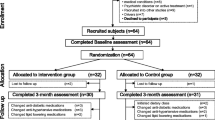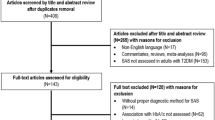Abstract
Obstructive sleep apnea (OSA) is independently associated with glucose intolerance and insulin resistance, and recent studies have shown that continuous positive airway pressure (CPAP) improves insulin sensitivity. The objective of this study was to describe the change in glycosylated hemoglobin (HbA1c) after treatment with CPAP in patients with type 2 diabetes mellitus and OSA. To test this hypothesis, we performed a retrospective analysis of 38 patients seen in the sleep clinic of an urban public teaching hospital. All patients had OSA and type 2 diabetes mellitus, and their diabetic medication regimen had remained unchanged during the period of CPAP therapy. Sixty-one percent were men, body mass index was 42±9.5 kg/m2, and the Apnea–Hypopnea Index was 53±36 per hour. HbA1c before therapy with CPAP was 7.8±1.4% and decreased to 7.3±1.3% after 134±119 days of therapy (p<0.001). Treatment with CPAP leads to a clinically significant drop in HbA1c in patients with type 2 diabetes mellitus and severe OSA.
Similar content being viewed by others
References
Grunstein R, Wilcox I, Yang TS, Gould Y, Hedner J (1993) Snoring and sleep apnoea in men: association with central obesity and hypertension. Int J Obes Relat Metab Disord 17:533–540
Jennum P, Schultz-Larsen K, Christensen N (1993) Snoring, sympathetic activity and cardiovascular risk factors in a 70 year old population. Eur J Epidemiol 9:477–482
Tiihonen M, Partinen M, Narvanen S (1993) The severity of obstructive sleep apnoea is associated with insulin resistance. J Sleep Res 2:56–61
Elmasry A, Janson C, Lindberg E et al (2000) The role of habitual snoring and obesity in the development of diabetes: a 10-year follow-up study in a male population. J Intern Med 248:13–20
Vgontzas AN, Papanicolaou DA, Bixler EO et al (2000) Sleep apnea and daytime sleepiness and fatigue: relation to visceral obesity, insulin resistance, and hypercytokinemia. J Clin Endocrinol Metab 85:1151–1158
Elmasry A, Lindberg E, Berne C et al (2001) Sleep-disordered breathing and glucose metabolism in hypertensive men: a population-based study. J Intern Med 249:153–161
Al-Delaimy WK, Manson JE, Willett WC, Stampfer MJ, Hu FB (2002) Snoring as a risk factor for type II diabetes mellitus: a prospective study. Am J Epidemiol 155:387–393
Manzella D, Parillo M, Razzino T et al (2002) Soluble leptin receptor and insulin resistance as determinant of sleep apnea. Int J Obes Relat Metab Disord 26:370–375
Punjabi NM, Shahar E, Redline S et al (2004) Sleep-disordered breathing, glucose intolerance, and insulin resistance: the sleep heart health study. Am J Epidemiol 160:521–530
Punjabi NM, Sorkin JD, Katzel LI et al (2002) Sleep-disordered breathing and insulin resistance in middle-aged and overweight men. Am J Respir Crit Care Med 165:677–682
Ip MS, Lam B, Ng MM et al (2002) Obstructive sleep apnea is independently associated with insulin resistance. Am J Respir Crit Care Med 165:670–676
DeFronzo R, Tobin J, Andres R (1979) Glucose clamp technique: a method for quantifying insulin secretion and resistance. Am J Physiol 237:E214–E223
Brooks B, Cistulli PA, Borkman M et al (1994) Obstructive sleep apnea in obese noninsulin-dependent diabetic patients: effect of continuous positive airway pressure treatment on insulin responsiveness. J Clin Endocrinol Metab 79:1681–1685
Harsch IA, Schahin SP, Bruckner K et al (2004) The effect of continuous positive airway pressure treatment on insulin sensitivity in patients with obstructive sleep apnoea syndrome and type 2 diabetes. Respiration 71:252–259
Harsch IA, Schahin SP, Radespiel-Troger M et al (2004) Continuous positive airway pressure treatment rapidly improves insulin sensitivity in patients with obstructive sleep apnea syndrome. Am J Respir Crit Care Med 169:156–162
Babu AR, Herdegen J, Fogelfeld L, Shott S, Mazzone T (2005) Type 2 diabetes, glycemic control, and continuous positive airway pressure in obstructive sleep apnea. Arch Intern Med 165:447–452
Rechtschaffen A, Kales A (1968) A manual of standardized terminology, techniques and scoring systems for sleep stages of human subjects. Brain Information Service/Brain Research Institute, University of California Los Angeles, Los Angeles
The Report of an American Academy of Sleep Medicine Task Force (1999) Sleep-related breathing disorders in adults: recommendations for syndrome definition and measurement techniques in clinical research. Sleep 22:667–689
Smurra M, Philip P, Taillard J et al (2001) CPAP treatment does not affect glucose-insulin metabolism in sleep apneic patients. Sleep Med 2:207–213
Stoohs RA, Facchini F, Guilleminault C (1996) Insulin resistance and sleep-disordered breathing in healthy humans. Am J Respir Crit Care Med 154:170–174
Yki-Jarvinen H (2004) Thiazolidinediones. N Engl J Med 351:1106–1118
Boule NG, Haddad E, Kenny GP, Wells GA, Sigal RJ (2001) Effects of exercise on glycemic control and body mass in type 2 diabetes mellitus: a meta-analysis of controlled clinical trials. JAMA 286:1218–1227
UK Prospective Diabetes Study (UKPDS) Group (1998) Effect of intensive blood–glucose control with metformin on complications in overweight patients with type 2 diabetes (UKPDS 34). Lancet 352:854–865
Molyneaux LM, Constantino MI, McGill M, Zilkens R, Yue DK (1998) Better glycaemic control and risk reduction of diabetic complications in type 2 diabetes: comparison with the DCCT. Diabetes Res Clin Pract 42:77–83
Author information
Authors and Affiliations
Corresponding author
Rights and permissions
About this article
Cite this article
Hassaballa, H.A., Tulaimat, A., Herdegen, J.J. et al. The effect of continuous positive airway pressure on glucose control in diabetic patients with severe obstructive sleep apnea. Sleep Breath 9, 176–180 (2005). https://doi.org/10.1007/s11325-005-0033-y
Published:
Issue Date:
DOI: https://doi.org/10.1007/s11325-005-0033-y




